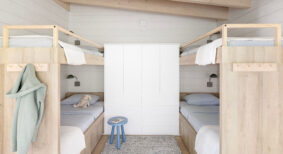As evidenced at this year’s KBIS (Kitchen and Bathroom Industry Show), one trend gaining significant ground in the kitchen and bath industry is the use of exotic veneers.
Although a mix of these materials emerged a couple of years ago, the use of exotic veneers in cabinetry, counter tops, flooring, wall panels, and other kitchen and bathroom products is really hitting its stride today.
Trends in exotic veneers include:
- tile and wall panels that use wood in a three dimensional grid showing basket weave patterns and relief patterns;
- mixing different wood species in the same kitchen;
- a return to hickory and some of the wild grain patterns in wood floors.
Given the popularity of these trends, it is clear that the consumer is yearning for surface interest and the layering of materials in the kitchen and bathroom space. The push for exotic veneers, such as Lyptus and Bamboo, began during the green movement when the consumer started requesting woods that were considered sustainable and could be harvested quickly as a renewable resource. Wood options have since expanded to meet demand. In addition to Bamboo and Lyptus, we are seeing a lot of Plantation Beech because of its renewable wood status.
A trend often starts at the higher end of a market and is then replicated in the medium or lower price points. The design industry is now seeing this style aesthetic at every price point. Cabinet materials have expanded to include not only the real woods but also the exotic woods in thermofoil, melamine, and laminate versions.
If the green movement is in part responsible for the exotic veneer trend, then so is the popularity of contemporary design. The strong influence of cleaner lines in kitchens and bathrooms has triggered a renewed appreciation for product surface interest – cleaning up the embellishments characteristic of traditional kitchens and bathrooms of the past, but keeping the uniqueness.
The eye still wants to be enticed, not bored with too much of the sameness in materials and as such exotic veneers add dynamic interest and warmth. We are now seeing textural qualities including wire-brushed wood, thermofoil cabinet doors with texture, and graphite grey stains on quarter sawn and rift cut white oak.
Counter-tops in an assortment of exotic wood species are being featured more and more in contemporary kitchen and bath design, as evidenced by The Grothouse Lumber Company. Its ‘Green Living Initiative’ also makes it clear that the consumer does care about the environmental impact of harvesting exotic woods.
In addition to cabinetry and counter-tops, the exotic veneer trend was apparent in other materials at the KBIS – from ceramic tile that looked like exotic wood to reclaimed wood being used in flooring, wall panelling, and furniture pieces.
We are also starting to see some Live Edge details on wood counter-tops. As this trend develops, more organic materials will be included as an adjunct to the exotic veneer look.
It is clear that today’s discriminating consumer is drawn to inherently true materials. As such, demand for green products and renewable wood materials will only increase, as will the use of exotic veneers and related organic materials in contemporary design.
Heidi Schumann is principal and owner of Design Details Inc. in Qualicum Beach.







